I’ve had a look at the case study for the June (operator) CPC and it mentions a significant amount of info about the firm’s dangerous goods transport operations. The first thing that strikes me is that there are no UN numbers mentioned. Actually, that plays right into your hands because they can’t ask you what the ADR limit is, AND you can assume that the fireworks (UN Class 1) and the disinfectant (UN Class 8 ) will be subject to full ADR when loaded.
(That keeps things relatively straightforward, because there won’t be any load calculations to do. ![]() )
)
I’m using quotes to each mention of ADR info given in the case-study scenario from OCR and giving you my thoughts on the likely questions and some ADR facts and figures that you might weave into your case-study answers…
The case-study:
The main operation of the business is the distribution of a range of solvents and resins (Class 3) across the UK in approved articulated tankers.
The “approval” for the tankers is required because they are FL (flammable liquid) specification.
FL spec (Box #7 in the certificate below) includes special wiring, and an electrical isolator switch that doesn’t disrupt the tachograph.
The approval requires a type-approval certificate from the manufacturer of the tank. Then when the tank is built onto a trailer, the whole thing needs an Certificate of ADR Approval from a VOSA testing station. The pink stripe on the certificate below IS SPECIFICALLY MENTIONED IN ADR. (No photocopies ![]() )
)
In addition to the normal M.O.T Test, a ‘leakproof’ test is carried out every THREE years, and a full test is carried out every SIX years.
To drive these vehicles, a driver will need a correct driving licence for category C+E (Check the driving licence restriction codes in the scenario ![]() ) PLUS a minimum ADR certificate for ‘in tanks’ and UN Class 3. The driver’s ADR certificate must be an original and be carried at all times when the vehicle is subject to ADR Regs. (Production of a driver’s ADR certificate is ‘upon demand’ and there is NO seven-day allowance for production at a police station as there is with a driving licence.)
) PLUS a minimum ADR certificate for ‘in tanks’ and UN Class 3. The driver’s ADR certificate must be an original and be carried at all times when the vehicle is subject to ADR Regs. (Production of a driver’s ADR certificate is ‘upon demand’ and there is NO seven-day allowance for production at a police station as there is with a driving licence.)
These vehicles will ALWAYS be fully subject to ADR (even when empty of cargo) unless the driver is in possession of a certificate stating that the tank and all its equipment and hoses have been cleaned and purged of all dangerous goods.
The driver must be in possession of means of identification which includes a photograph. (Photo ID)
The driver must also be in possession of a transport document (a correctly completed delivery note) AND ‘Instructions in Writing,’ consisting of four pages which must be printed in colour.
Compulsory Vehicle Equipment
2 x self standing warning signs (eg. cones or triangles or orange flashing lights.)
A suitable wheel-chock
Eye rinsing liquid
Compulsory extra equipment when carrying UN Class 3
A shovel
A drain seal
A collecting container made of plastics
Compulsory Personal Equipment (For each crew member)
A warning vest (Hi-Viz.)
Portable lighting apparatus (Torch)
A pair of protective gloves
Eye protection (Goggles.)
(A respirator is NOT required.)
Tank vehicle markings for UK domestic dangerous goods traffic.
1 x plain orange coloured plate. [40cm X 30cm] (To be displayed on the front of the vehicle.)
3 x hazard warning panels. [70cm X 40cm] (One to be displayed on the rear and one on each side.)
![]()
![]() Don’t mix-up the names for these, they are very specific.
Don’t mix-up the names for these, they are very specific. ![]()
Plain orange coloured plate:

Sample Hazard Warning Panel:

Top left portion = Emergency Action Code (EAC)
Middle left portion = UN Number of goods carried
Bottom left portion = Specialist advice phone number
Top right portion = Class placard appropriate to UN Class of substance
Bottom right portion = Space reserved for company logo (Not compulsory, so can be left plain.)
For the fire extinguisher requirements, please see below.
ADR Certificate of Approval:
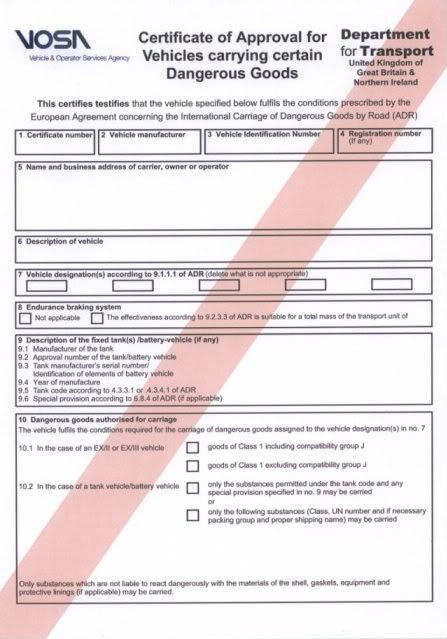
The case-study:
In addition the business also distributes fireworks (Class 1) for a major national firework manufacturer in approved curtain-sided rigid/drawbar trailer combinations.
“Approval” for vehicles that are to carry explosives (the fireworks) is called EX/II or EX/III (Also box #7 in the certificate above.)
BE AWARE that fireworks in Division 1.4S DO NOT NEED AN ADR TRAINED DRIVER, NOR IS AN APPROVED VEHICLE NEEDED for 1.4S, regardless of what quantity / weight is carried.
However, the case study has mentioned ‘approved’ vehicles, so it must be the meatier types of fireworks that are being carried.
Fireworks may be either 1.1G, 1.2G, 1.3G, or 1.4G, which for this scenario will most probably need an ADR trained driver with UN Class 1 (in packages) on their ADR certificate.
Explosives are no different to other dangerous goods in that there is a ‘trigger’ limit that brings the ADR Regs into effect for a particular journey.
(No UN Number is given, nor is there a division nor a compatibility letter, so we can assume a load to be fully subject to ADR.)
When carrying explosives in the UK on a domestic journey, the UK ‘trigger’ limits (1A and 2A in red below) are more generous than those in ADR.
TC 0 limit = 0
TC 1 limit = 20kg
TC 1A limit = 50kg (UK only)
TC 2 limit = 333kg
TC 2A limit = 500kg (UK only)
TC 3 limit = 1,000kg
TC 4 limit = unlimited
The weight of UN Class 1 goods in kgs is calculated (for ADR purposes) by adding the NEQs (or NEMs) together.
NEQ = Nett Explosive Quantity
NEM = Nett Explosive Mass
NEQ and NEM both mean the same thing, which is: The actual weight of explosive material ONLY.
So, you WOULDN’T count the weight of any pallets, wrappings or the boxes. This includes also ignoring the weight of the cardboard tubes and plastic spikes commonly used in the manufacture of most fireworks.
As an example, this box of booster cartridges weighs 8.5kg, BUT you only count 3kg (NEM) in this instance.

Vehicle markings for the carriage of fireworks in approved vehicles
2 x orange coloured plate. [40cm X 30cm] (To be displayed on the front and rear of the vehicle.)
3 X Class 1 placards with the correct division and compatibility letter (To be displayed on the rear and both sides of the vehicle.)
Example of UN Class 1.2G placard: (With or without the word ‘explosive’ but the rest is compulsory)
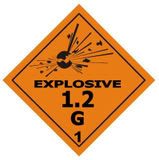
![]() 1.4S needs NO markings or plates for carriage by road.
1.4S needs NO markings or plates for carriage by road.
Compulsory Vehicle Equipment
2 x self standing warning signs (eg. cones or triangles or orange flashing lights.)
A suitable wheel-chock
Compulsory Personal Equipment (For each crew member)
A warning vest (Hi-Viz.)
Portable lighting apparatus (Torch)
A pair of protective gloves
Eye protection (Goggles.)
(A respirator is NOT required.)
The rules for fire extinguishers for the fireworks job are the same as for any other ADR regulated job.
The case-study:
The company also has a long standing contract to deliver disinfectants (Class 8, ) in 1000 litre Intermediate Bulk Containers (IBCs) to farms across the North West. This contract requires the use of 7.5 tonne curtain sided vehicles.
It’s great that they haven’t given a UN Number for the disinfectant, so they can only ask very general questions about the disinfectant job. Please make sure that you remember that an IBC counts as a PACKAGE
Here’s a piccy of the type of IBC they’re talking about.
(Please note that it’s an IBC and it counts as a package. DO NOT CALL IT A ‘TANK.’ ![]()
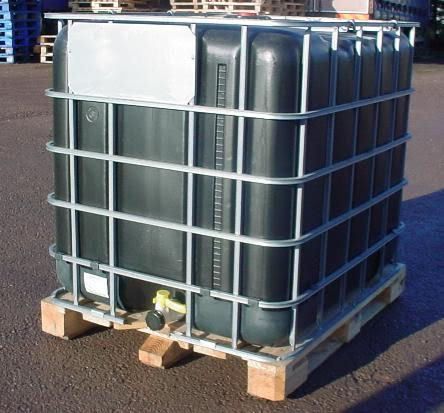
Here’s the UN PACKAGE approval mark relevant to an IBC of the type above:
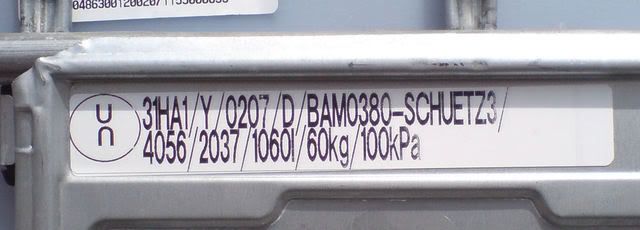
The IBCs must each be marked with a Class 8 label (100mm X 100mm) on two opposite sides and must also show the UN number of the disinfectant.

Vehicle markings for the disinfectant job:
2 X plain orange plates (one to be displyed on the front of the vehicle, the second to be displayed on the rear of the vehicle.)
 +
+ 
The vehicle for the Class 8 job doesn’t need any kind of approval, a standard vehicle is acceptable for this job.
The vehicle driver for this job needs a minimum of a C1 driving licence and an ADR certificate for packages and UN Class 8 .
![]()
![]() Watch out for the guy who passed his Cat “B” driving test in 1998.
Watch out for the guy who passed his Cat “B” driving test in 1998. ![]()
![]()
UK Driving Licence restriction codes are HERE
The vehicle and personal equipment list for UN Class 8 is exactly the same as for the tanker carrying the solvents and resins.
(A respirator is NOT required.)
Documentation for all ADR regulated work.
- The driver’s ADR certificate must be an original and be carried at all times when the vehicle is subject to ADR Regs.
- (Production of a driver’s ADR certificate is ‘upon demand’ and there is NO seven-day allowance for production at a police station as there is with a driving licence.)
- The driver must be in possession of means of identification which includes a photograph.
- The driver must also be in possession of a transport document (a correctly completed delivery note)
- ‘Instructions in Writing,’ consisting of four pages which must be printed in colour.
- Certificate of ADR approval for the UN Class 1 job and the UN Class 3 tanker job (But not for the UN Class 8 job.)
======================================================================================================
Rules for fire extinguishers:
1 X 2kg dry powder extinguisher suitable for fighting a fire in the engine or the cab of the vehicle.
Something like this:
 or this
or this 
In larger vehicles than those shown in the pics, the 2kg extinguisher can be mounted on the framework below the driver’s seat.
Carriage in excess of ADR threshold ( ie, when ADR applies in full)
You’ll need the 2kg extinguisher as above, PLUS one more extinguisher depending on the permitted G.V.W. of your vehicle as follows:
(The actual weight of goods that you’re carrying is irrelevant here ![]() )
)
Permitted G.V.W. less than 3,500 kgs needs ANOTHER 2kg extinguisher as above, making a total of 4kgs.
Permitted G.V.W. between 3,500kgs and less than 7,500kgs needs ANOTHER 6kg extinguisher making a total of 8kgs
Permitted G.V.W over 7,500kgs ie ANY LGV needs ANOTHER 10kg extinguisher making a total of 12kgs
Once the vehicle is an LGV, it doesn’t matter whether it’s a rigid, wag and drag or an artic ![]()
On most vehicles, the larger of the extinguishers is carried outside the vehicle in some kind of protective covering,
something like this:
Other requirements:
-
Extinguishers must be of an approved type ie. the Kite Mark or the CE mark.
-
Extinguishers must be periodically inspected and bear a label / sticker showing the next due date of inspection
-
Extinguishers must be fitted with a seal AND pin
Something like this:
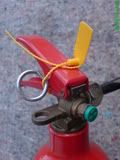
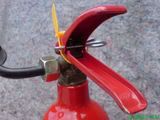
-
Extinguishers must be protected from the effects of the weather.
-
Extinguishers must be easily accessible.
-
A gauge isn’t compulsory, but if one is fitted, the needle must point to the green sector.
![]() If any required feature of a fire extinguisher is missing, you don’t have a fire extinguisher and you’ll be dealt with accordingly. (You win a PG9
If any required feature of a fire extinguisher is missing, you don’t have a fire extinguisher and you’ll be dealt with accordingly. (You win a PG9 ![]() )
)
POSSIBLE BANANA SKINS FOR THE UNWARY ![]()
The 7.5t vehicle for the disinfectant job needs 1 X 2kg fire extinguisher + 1 X 6kg fire extinguisher ( = 2 extinguishers)
and a Weather Proof Container for the 6 kg fire extinguisher.
The vehicles for the other two jobs are LGVs, so they need 1 X 2kg fire extinguisher + 1 X 10kg fire extinguisher, BUT the equipment list does NOT offer you a 10kg extinguisher.
To make the required total of 12 kg, you might consider 1 X 2kg + 2 X 6kg to make a total of 14kg but PLEASE DON’T FORGET that you’d then need 2 X Weather Proof Containers for the 6 kg fire extinguishers.
ADR drivers certificates (VTCs) are valid for 5 years and can be refreshed at any time in the last year (ie, after 4 years) but with NOT less than four weeks validity remaining.
Make sure that you know and understand the difference between an orange coloured plate and a hazard warning panel.
Don’t forget that an IBC is a package, an IBC is NOT a tank.
To make the scenario as realistic as possible, here is a driver’s ADR certificate for you to check:
A driver’s ADR certificate:
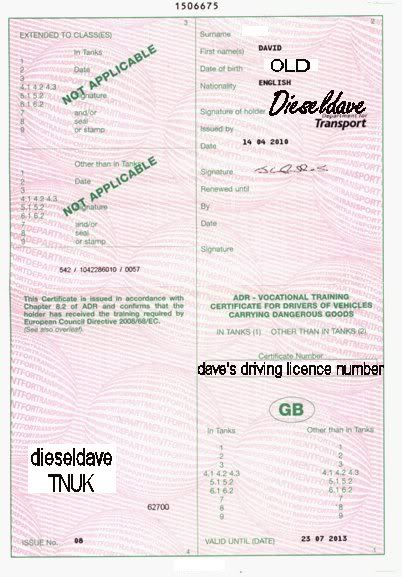
Staying with reality, the scenario clearly says that your company has a DGSA, so there’s no harm in asking his advice cos that’s what he’s there for. ![]()
A DGSA certificate:

Good luck and please feel free to ask questions. ![]()
After the exams, please let me know whether this post was anywhere near the mark. ![]()
![]()



